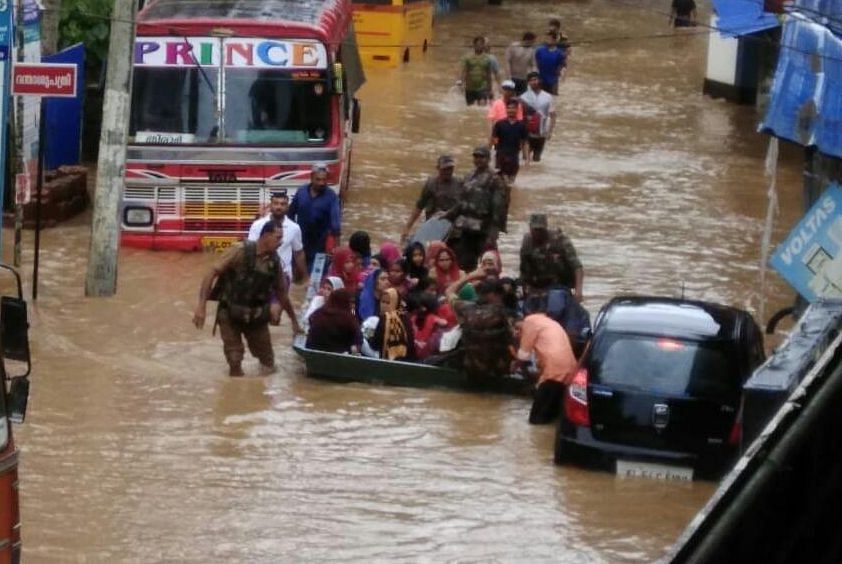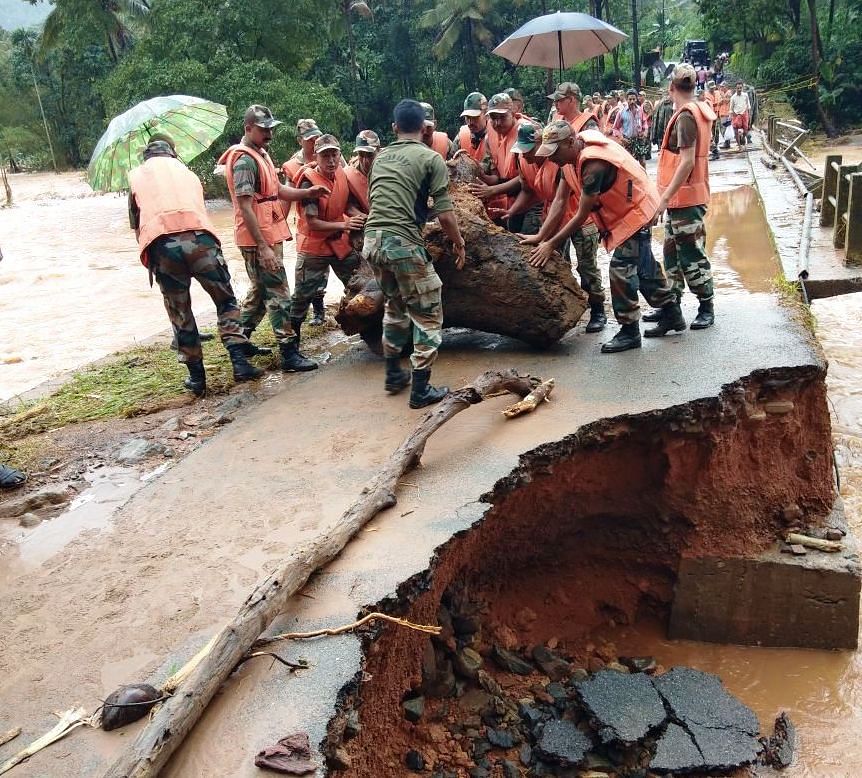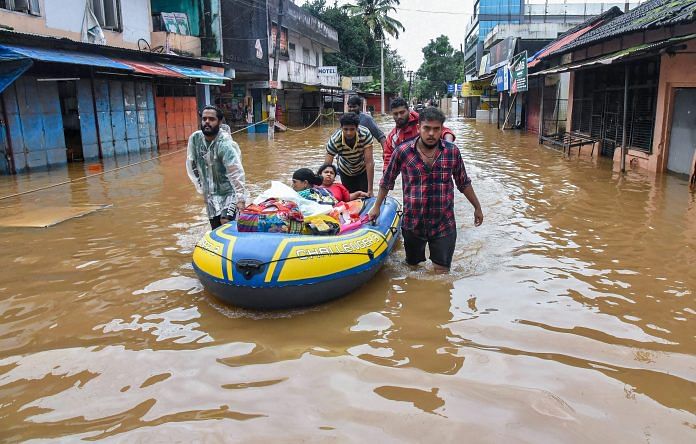It’s not just ‘nature’s fury’ which has led to this disaster – experts say most of the damage is due to poor land and river management.
Thiruvananthapuram: Several thousand people are still stranded or marooned in Kerala, even as rescuers battle the inclement weather to save as many lives as possible. The state administration, in tandem with hundreds of troops from the central armed and reserve forces, are working round the clock to ensure rescue and relief. Phones at the disaster management cell in the secretariat don’t stop ringing, but every single stationed official is making sure each call is answered and the message is sent out to the rescue teams.
Despite all this, 324 lives have so far been officially declared lost, with fears that the toll could still climb much higher.

Kerala chief minister Pinarayi Vijayan has compared the situation to the floods of 1924, which had almost washed away the beautiful coastal state.
The floods of 1924
Known locally as “99le velapokkam” (floods of the Malayalam calendar year 1099), chronicles of that time say rain battered the state for nearly three weeks, submerging districts from Thrissur to Idukki, extending up to Kuttanad. Some even say that a “huge mountain” called Karinthiri Mala was washed away and the entire connectivity to Munnar lost with it.
“If you correlate the data for Idukki, the water is 1.4 times higher than what we had in the flood of 1961. Moreover, historical data indicates that the 1924 flood was 1.6 times higher than 1961, so this year’s floods are more or less close to 1924’s. There may be some areas where there may be more flooding, we have to wait and see,” James Wilson, Kerala’s special officer for inter-state water, told ThePrint.
Also read: Understanding the 42-year-old Idukki dam which is now saving Kerala
Why did Kerala face such floods?
According to the director of Indian National Centre for Ocean Information Services (INCOIS) Dr Satheesh Shenoi, the unprecedented rains are due to an abnormality of the low pressure area that builds up annually over the Bay of Bengal, which causes the south-west monsoon.
“The low pressure usually moves towards central India, Rajasthan and Gujarat. However, this time, the low pressure spread over a much larger area, causing abnormally gusty winds and resulting in these floods,” he explained.
Prof. P.V. Joseph, former director of the India Meteorological department (IMD), observed that between 1 June and 17 August, Kerala has received over 41 per cent more rainfall than the long period average, while the whole of India has had eight per cent less rainfall than average.
“What is ironic is that Kerala is one of the few meteorological sub-divisions of India where the south-west monsoon rainfall of the last 100 years had shown a decreasing trend. Many atmospheric and oceanic features have caused such a situation,” he said.
Some experts say that another reason for this disaster is not just the high population density of the state (third highest if one excludes union territories), but that the exit points for the water to flow into the Arabian Sea are extremely narrow.
“It is like you are filling a bucket with water. If there is a narrow hole in it, the water will flow out of it as long its inflow is steady. But if there is a sudden rush of water, it will spill over the rim. That is exactly what happened,” explained a government official who wished to remain anonymous.
Tamil Nadu should have cooperated
Meteorologists and geologists say apart from better planning in Kerala itself, the impact of these floods could’ve been reduced if neighbouring Tamil Nadu had allowed the diversion of some water towards the Mullaperiyar reservoir. The Mullaperiyar dam and its reservoir stands in Kerala, but is operated by the Tamil Nadu government.
James Wilson strongly believes that had the Tamil Nadu government set aside all disputes temporarily and started gradual controlled releases from the Mullaperiyar dam at a lower level, a lot of the damage that was faced along the Periyar river would have been reduced.

“If they had agreed to a gradual release, it would have allowed us to evenly distribute the spill from Idukki… and more controlled releases,” Wilson said.
Also read: ‘Who visited Kerala’s flood-hit first?’ BJP finds a way to score brownie points
In fact, chief minister Vijayan wrote to his Tamil Nadu counterpart Edappadi Palaniswami about this, but the latter responded by saying: “The (Mullaperiyar) dam is safe and Tamil Nadu government is maintaining the releases through the spillways so as not to exceed the permitted water storage level at 142 feet. Therefore, there is no threat to the safety of the dam and water is being stored at the permitted level of 142 feet as per the orders of the Supreme Court.”
However, the Supreme Court has pulled up both state governments for squabbling while lives were at stake. It has suggested to the National Crisis Management Committee and the supervisory committee monitoring the Mullaperiyar dam to work out a formula to reduce the water level to 139 feet.
Man-made calamity
Prof. Joseph says there is an urgent need for land management; floods depend more on river and land management than rainfall. This year, the flood became acute after the sluices of the dams were opened, which could not be avoided.
Also read: Devastating Kerala floods: National indifference or political partisanship?
Land management should involve adequate provision for water flow over the land in heavy rainfall situations, and strict regulations for construction of houses in landslide prone areas.
A large number of people lost their lives in landslides, which is why Madhav Gadgil, ecologist and founder of the Centre for Ecological Sciences at the Indian Institute of Science, Bengaluru, believes that it was a man-made calamity.
The report has been corrected to accurately reflect the comment made by Kerala’s special officer for inter-state water, James Wilson, on Tamil Nadu.







This article is bull shit,just a hate mongering article between Tamils and keralities,stop this behaviour.
This is a stupid article , Tamilnadu is working closely with our malayali brothers….. be it relief, food or effort … This editor should be jailed for promoting such Ill found lies
If what is stated in the column is correct, the Tamil Nadu government has been not just obdurate but criminally culpable. In an emergency, the authorities in Kerala ought to have physically overcome the TN staff and opened the sluice gates themselves. Not a time to be writing letters, ending with, With regards, Yours sincerely …